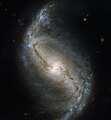NGC 986
| Galaxie NGC 986 | |
|---|---|
 | |
| Aufnahme des Very Large Telescopes | |
| AladinLite | |
| Sternbild | Chemischer Ofen |
| Position Äquinoktium: J2000.0, Epoche: J2000.0 | |
| Rektaszension | 02h 33m 34,3s [1] |
| Deklination | −39° 02′ 42″ [1] |
| Erscheinungsbild | |
| Morphologischer Typ | (R'_1)SB(rs)b / HII[1] |
| Helligkeit (visuell) | 10,8 mag[2] |
| Helligkeit (B-Band) | 11,6 mag[2] |
| Winkelausdehnung | 4′ × 3,2′[1] |
| Positionswinkel | 150° |
| Flächenhelligkeit | 13,4 mag/arcmin²[2] |
| Physikalische Daten | |
| Rotverschiebung | 0.006585 ± 0.000019[1] |
| Radialgeschwindigkeit | (1974 ± 6) km/s[1] |
| Hubbledistanz H0 = 73 km/(s • Mpc) | (84 ± 6) · 106 Lj (25,7 ± 1,8) Mpc [1] |
| Durchmesser | 100.000 Lj[3] |
| Geschichte | |
| Entdeckung | James Dunlop |
| Entdeckungsdatum | 5. August 1826 |
| Katalogbezeichnungen | |
| NGC 986 • PGC 9747 • ESO 299-07 • MCG -07-06-015 • IRAS 02315-3915 • SGC 023134-3915.9 • AM 0231-391 • GC 567 • h 2487 • Dun 519 • HIPASS J0233-39 | |
NGC 986 ist eine Balkenspiralgalaxie vom Hubble-Typ SBab im Sternbild Chemischer Ofen (Fornax) am Südsternhimmel, die schätzungsweise 85 Millionen Lichtjahre von der Milchstraße entfernt ist.
Das Objekt wurde am 5. August 1826 von James Dunlop entdeckt.[4]
- Hochaufgelöste Aufnahme des Zentrums von NGC 986, erstellt mithilfe des Hubble-Weltraumteleskops.
- Ultraviolettaufnahme mittels GALEX. Junge Sterne treten blau hervor, ältere erscheinen gelb.
Weblinks
- ESO: Die unbekannte Schöne
- astronews.com: Bild des Tages 1. Februar 2016
- A spiral in a furnace (engl.)
- CDS Portal
Einzelnachweise
Auf dieser Seite verwendete Medien
NGC 986 by GALEX
Autor/Urheber: Credit: ESA/Hubble & NASA, Lizenz: CC BY 3.0
A spiral in a furnace
This new Hubble image is a snapshot of NGC 986 — a barred spiral galaxy discovered in 1828 by James Dunlop. This close-up view of the galaxy was captured by Hubble’s Wide Field and Planetary Camera 2 (WFPC2).
NGC 986 is found in the constellation of Fornax (The Furnace), located in the southern sky. NGC 986 is a bright, 11th-magnitude galaxy sitting around 56 million light-years away, and its golden centre and barred swirling arms are clearly visible in this image.
Barred spiral galaxies are spiral galaxies with a central bar-shaped structure composed of stars. NGC 986 has the characteristic S-shaped structure of this type of galactic morphology. Young blue stars can be seen dotted amongst the galaxy’s arms and the core of the galaxy is also aglow with star formation.
To the top right of this image the stars appear a little fuzzy. This is because a gap in the Hubble data was filled in with data from ground-based telescopes. Although the view we see in this filled in patch is accurate, the resolution of the stars is no match for Hubble’s clear depiction of the spiral galaxy.
Credit:
ESA/Hubble & NASA
About the Object
Name: NGC 986
Type: • Local Universe : Galaxy : Type : Barred
• X - Galaxies Images/Videos
Distance: 55 million light years
Colours & filters Band Wavelength Telescope
Optical B 450 nm Hubble Space Telescope WFPC2 Infrared I 814 nm Hubble Space Telescope WFPC2.
Autor/Urheber: ESO, Lizenz: CC BY 4.0
An Often Ignored Beauty This picture of the week shows the spiral galaxy NGC 986 in the constellation of Fornax (The Furnace). The galaxy, which was discovered in 1826 by the Scottish astronomer James Dunlop, is not often imaged due to its proximity to the famous and rich Fornax Cluster of galaxies. Which is a shame, as this galaxy is not only a great scientific object, but also very pretty. The galaxy is about 56 million light-years away and seen almost perfectly from the top, or — as astronomers say — face-on. This allows us to see the two main spiral arms and also a central bar-shaped structure, composed of stars and dust, which makes it a barred spiral galaxy. Astronomical surveys have shown that about two thirds of all spiral galaxies contain a bar, including the Milky Way. This makes NGC 986 the perfect place to study the structure of galaxies and find out more about our own home galaxy, which is difficult to study from within. This view from the FORS instrument on ESO’s Very Large Telescope at the Paranal Observatory in northern Chile comes from the ESO Cosmic Gems programme, an outreach initiative to produce images of interesting, intriguing or visually attractive objects using ESO telescopes, for the purposes of education and public outreach. The programme makes use of telescope time that cannot be used for science observations. All data collected may also be suitable for scientific purposes, and are made available to astronomers through ESO’s science archive.




